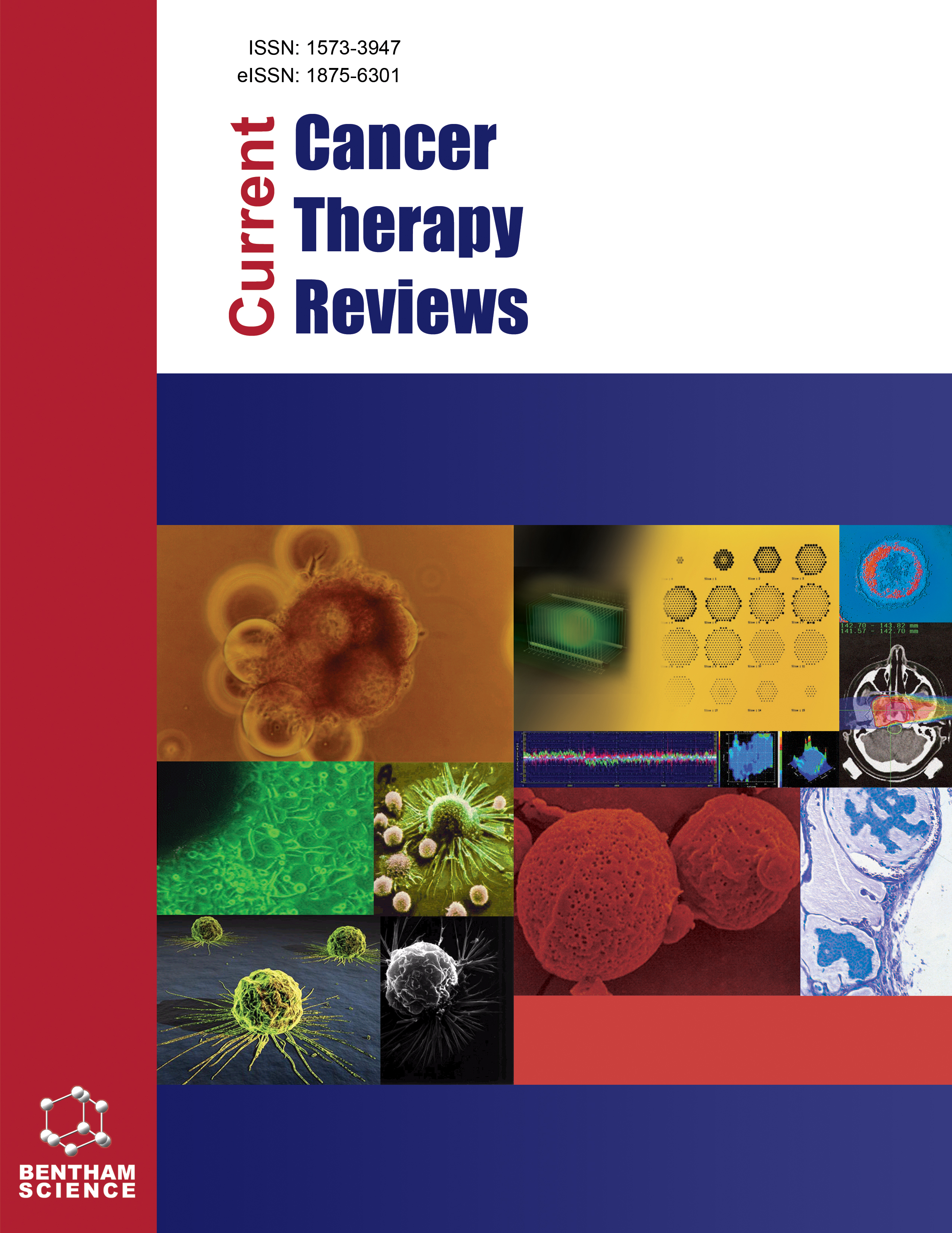- Home
- A-Z Publications
- Current Cancer Therapy Reviews
- Previous Issues
- Volume 4, Issue 3, 2008
Current Cancer Therapy Reviews - Volume 4, Issue 3, 2008
Volume 4, Issue 3, 2008
-
-
Editorial [Hot Topic: Cancer and Stem Cells (Guest Editor: Eiichi Tahara)]
More LessRecent advances in stem cell biology have highlighted the “cancer stem cell hypothesis”. This hypothesis constitutes two important related concepts. The first is that cancers arise from the mutational transformation of normal stem cells or restricted progenitors/differentiated cells that acquire self-renewal potential. The second is that cancers contain a small subset with stem cell like properties that are responsible for th Read More
-
-
-
Cancer and Stem Cells
More LessAuthors: Lydia Gutierrez-Gonzalez, Osamu Inatomi, Julia Burkert and Nichoals A. WrightScientists have tried for many years to understand cancer development and progression in the expectation of defining the therapeutic target. Emerging evidence has revealed that cancers contain a minority population, termed “Cancer stem cells (CSCs)”, which are responsible for sustaining the tumour as well as giving rise to proliferating cells. CSCs are thought share the three features with normal stem cells: self-r Read More
-
-
-
The Molecular Bases of the Self-Renewal and Differentiation of Leukemic Stem Cells
More LessAuthors: Kazuhito Naka, Masako Ohmura, Takayuki Hoshii, Teruyuki Muraguchi and Atsushi HiraoNew evidence has dramatically demonstrated that only a minority of cancer cells has the capacity to proliferate extensively and form new tumors; these cells are called “tumor-initiating cells” or “cancer stem cells”. In this review, we focus on recent molecular insights into the nature of cancer stem cells in leukemia, leukemic stem cells (LSCs). LSCs arise not only from primitive hematopoietic stem cells (HSCs) with self-renewal Read More
-
-
-
Runx1/AML1 is a Guardian of Hematopoietic Stem Cells
More LessAuthors: Lena Motoda, Motomi Osato and Yoshiaki ItoAn oncogenic stimulus in a cell primarily results in hyperproliferation. However, uncontrolled cell proliferation is sensed by the cell and triggers a fail-safe mechanism resulting in senescence, apoptosis, or differentiation. This phenomenon is considered to be a cellular fail-safe mechanism to eliminate undesirable cells from a population of healthy cells. The RUNX1/AML1 gene, one of the most frequently targeted genes in hum Read More
-
-
-
TGF-β Signaling in Gastrointestinal Cancer Stem Cells
More LessAuthors: Chohee Yun, Jonathan Mendelson, Young W. Kim and Lopa MishraThe TGF-β signaling pathway plays a significant role in various biological phenomena such as cell growth, embryogenesis, differentiation, morphogenesis and apoptosis. Gastrointestinal endodermal stem cells, influenced by TGF- β signals, undergo asymmetric cell division that leads to differentiation into tissue-specific functional cells such as hepatocytes and gut epithelial cells. Disruption of this process results in tissue-s Read More
-
-
-
Stem Cell-Like Brain Cancer Cells
More LessBy Toru KondoBoth stem cells and cancer cells can proliferate indefinitely. In many case, cancers consist of the cells expressing tissue-specific stem cell markers and the cells expressing differentiation markers. Moreover, it has been revealed that many cancer cells express ATP-binding cassette (ABC) transporters, by which the cells pump out a specific fluorescence dyes as well as anti-cancer drugs. Thus these finding suggest that eith Read More
-
-
-
Telomere End Protection in Stem Cells and Cancer Cells
More LessLoss of telomere DNA in normal somatic cells is a major alteration upon ageing. Stem cells and progenitor cells also lose telomere DNA, but at a slower rate than normal cells due to activation of a low level of telomerase activity. Embryonic stem cells exhibit strong telomerase activity, maintain telomere length, and are resistant to DNA damage. In contrast, hematopoietic stem cells, which have weak telomerase activity Read More
-
-
-
Role of mTOR in Hematological Malignancies
More LessAuthors: Uzma Athar and Ajeet GajraThe phosphoinositide 3-kinase (PI3K)/AKT pathway plays an important role in cancer development and progression. Mammalian target of rapamycin (mTOR) is a downstream effector of this pathway and is responsible for various cellular functions including mRNA translation, cell cycle progression and cellular proliferation. Activation of the PI3K/AKT pathway plays an important role in normal and neoplastic T and B cell p Read More
-
-
-
New Developments in Systemic Therapy for Hepatocellular Carcinoma
More LessUnresectable or metastatic hepatocellular carcinoma (HCC) carries a poor prognosis. Hepatic reserve often dictates the therapeutic options. There have been multitudes of negative systemic therapy trials for advanced HCC unsuitable for surgical and locoregional therapy up until now. Hormonal drugs, such as tamoxifen or immune response modifiers such as interferon and thalidomide are mostly ineffective. Recently, long-acting Read More
-
-
-
The Role of Mammalian Target of Rapamycin (mTOR) Inhibitors in the Treatment of Solid Tumors
More LessAuthors: Arun Rajan and Ajeet GajraMammalian target of rapamycin (mTOR) is a cytoplasmic kinase that is a downstream component of the phosphatidylinositol 3-kinase (PI3K)/Akt kinase cascade. Together with its associated proteins, it can affect mRNA transcription, protein translation, protein degradation and changes in the actin cytoskeleton. Since mTOR has the ability to influence cell proliferation and apoptosis, it plays an important role in carcinogenesis. T Read More
-
Volumes & issues
-
Volume 21 (2025)
-
Volume 20 (2024)
-
Volume 19 (2023)
-
Volume 18 (2022)
-
Volume 17 (2021)
-
Volume 16 (2020)
-
Volume 15 (2019)
-
Volume 14 (2018)
-
Volume 13 (2017)
-
Volume 12 (2016)
-
Volume 11 (2015)
-
Volume 10 (2014)
-
Volume 9 (2013)
-
Volume 8 (2012)
-
Volume 7 (2011)
-
Volume 6 (2010)
-
Volume 5 (2009)
-
Volume 4 (2008)
-
Volume 3 (2007)
-
Volume 2 (2006)
-
Volume 1 (2005)
Most Read This Month
Article
content/journals/cctr
Journal
10
5
false
en


